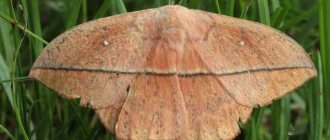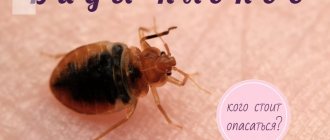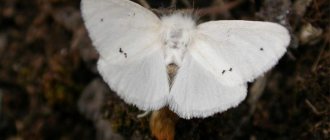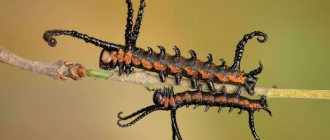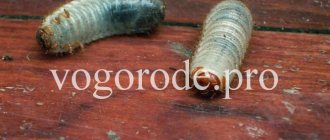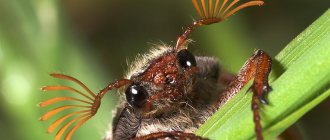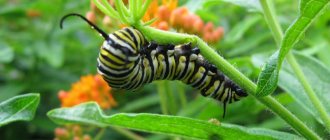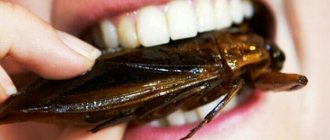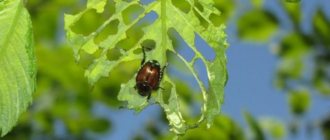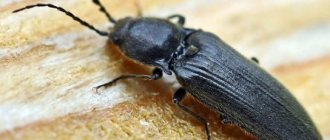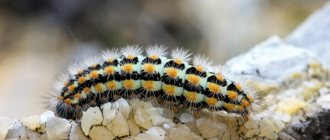Get ready for a journey into the colorful world of insects! You will see unusual butterflies and caterpillars common in the Moscow region, learn to identify them by their external signs and simply get aesthetic pleasure!
When we talk about the benefits of butterflies, we most often mean the properties of adult individuals. Thus, these insects are able to pollinate plants and attract birds to the garden. And if we mention harm, then here we are talking about the caterpillar stage, when the insect actively feeds on plants and can harm garden plantings. The butterflies themselves feed on nectar and are absolutely safe for plant health. Therefore, we will agree in advance that when we call a butterfly “harmful,” we mean its caterpillars.
Now let's take a closer look at the most common fluttering insects that you can find on your site, and determine which of them are useful and which are harmful!
Admiral - butterfly with stripes
Vanessa atalanta, wingspan 50-65 mm
The admiral is easy to recognize: there are red stripes on both sides of his wings. According to one version, it was thanks to this color that the butterfly got its name, because Russian admirals used to have ribbons over their shoulders and red stripes on their trousers. The lower wings of the insect are also decorated with red stripes, on which black dots are clearly visible. The edges of the wings are wavy.
You can meet such a beautiful butterfly not only in Russia, but also in North Africa, North America and even New Zealand. The admiral usually goes to southern countries to spend the winter, but sometimes hides under the bark of trees and remains there until spring. Previously, the admiral was included in the Red Book of Russia, but now the population has recovered.
animalreader.ru
It is not so easy to recognize the admiral's caterpillar as a future butterfly. Dark color, yellow dots on the sides of the body and frightening spikes - the insect is perfectly protected from birds and knows how to camouflage itself. It can be found from May to August on the leaves of nettles, hops and thistles.
How to attract an admiral butterfly. The Admiral loves thistles, asters and blackberries, and at the end of the season he is not averse to eating cracked plums and pears, especially if they have fermented. Place some fruit in a bowl and butterflies will flock to the smell. And to see the caterpillars, plant nettles on the site, which will also be useful as plant food.
The ancient Indians believed that if you catch a butterfly, whisper a cherished wish to it and release it into the wild, it will certainly come true. Try it!
Cetosia biblis
The pattern on the back of the wings of this delicate fluttering creature resembles Arabic writing, which was the name of the family - biblis, translated as “book”.
Insatiable caterpillars of cetosia eat poisonous plants, which subsequently make the insect larvae themselves poisonous. This is evidenced by the red-orange coloring of an already adult individual, warning of the danger of predators who want to feast on it.
In addition to its bright appearance, cetosia is also distinguished by its innate “cunning”. The moth knows how to pretend to be dead - sensing danger, the insect falls on its side and remains motionless until the threat has passed.
Hawthorn - beautiful and treacherous
Aporia crataegi, wingspan 50-65 mm
Hawthorn can often be found in gardens in the Moscow region. This beautiful butterfly with white wings decorated with black veins flies from apple tree to rosehip, from rowan to plum, from grape to pear to lay its eggs, from which voracious caterpillars will soon emerge. Hawthorn is a “relative” of the famous cabbage. Prefers wetlands and easily travels long distances in search of food and nesting sites.
nature.baikal.ru
Hawthorn caterpillars are covered with thick hairs and can gnaw an entire bush or tree in a short time. They grow slowly, so they make nests in trees for the winter. If leaves entangled with mulberry threads appear on the branches, rest assured that the hawthorn has settled in your garden!
How to deal with hawthorn and its caterpillars. You can place hunting belts on trees and put up birdhouses to attract birds. In early spring, it is worth spraying the plants with a solution of copper sulfate (100 g per 10 liters of water) with the addition of 500 g of urea. If there are a lot of pests, use insecticides: Alatar, Fatrin, Kinmiks, etc. Carry out the treatment during bud break, when the caterpillars emerge from their winter nests, or in the summer after the caterpillars hatch from their eggs.
Habitat
Moths are distributed almost everywhere; they cannot be found only in Antarctica. The ability of moths to fly is very developed, so they can be found both on the continent and on islands in the ocean.
Moths in central Russia are a fairly common phenomenon. They can be found even in the most abandoned places, traveling through the air on silk threads to which they are attached. In addition to this method of movement, caterpillars can move by attaching to broken branches of trees or whole logs that were moved from place to place after heavy rains or the flow of a river.
Some nocturnal moths live only in the habitats where they first appeared. For example, the yucca moth starts and lives only in yucca thickets.
The following moths are known in the Moscow region:
- fine strands;
- bagworms;
- wood borers;
- cocoon worms;
- birch silkworms;
- slugs;
- peacock eyes;
- corydalis;
- moths;
- nolides.
Cabbage is a dangerous pest of cabbage heads
Pieris brassicae, wingspan – 45-63 mm
Cabbage grass, or cabbage white, is familiar to every summer resident. You can find it in beds with cabbage, turnips, turnips and other cruciferous crops. The butterfly is fussily looking for a place to lay eggs, from which yellow-green caterpillars will soon appear. During the season, one individual lays up to 300 eggs!
Unprepossessing in appearance, the white hare terrifies with its appearance. You should especially be wary of females, the main difference of which is the black spots on the upper wings.
The voracious caterpillars of the white butterfly eat the leaves and prevent the head of cabbage from forming. After a while, only the veins remain from the leaf. When the food runs out, the pests crawl to new plantings.
How to deal with cabbage and its caterpillars. Safe methods include hand-picking caterpillars and catching butterflies. You can also plant marigolds, marigolds, mint or sage between the rows, which will repel pests. A good way is to cover the cabbage with a mosquito net and agro-canvas so that butterflies cannot lay eggs. Folk remedies will help by spraying 2 tbsp. mustard and 1 tsp. ground red pepper per 10 liters of water. And if there are a lot of insects, use Fitoverm, Karbofos, Actellik or another insecticide.
Life cycle
How long do moths live? The life cycle of these insects deserves close study; it can be divided into several successive stages:
- Eggs are laid by these moths either in the form of heaps or individual specimens. Moreover, females are able to lay them directly during flight, place them on objects or in vegetation tissues.
- After the allotted time, caterpillars emerge from the eggs, having a head, three pairs of legs with marigolds on the chest, and five pairs of legs on the body. After surviving periods of molting, the caterpillars are enclosed in a cocoon called a pupa. In it, the individual cannot move; the paws are tightly pressed to the body.
- After a while, an adult moth emerges from the pupa.
Urticaria - a connoisseur of birch sap
Aglais urticae, wingspan – up to 50 mm
You've probably seen this butterfly more than once, but you couldn't even imagine that the offspring of this luxurious beauty feed on stinging nettles! A special sign of urticaria is large black spots on dark orange wings. The hind wings are covered with small blue spots. The insect feeds on nectar of various flowers, and also does not refuse birch sap.
nasekomus.ru
One clutch of wren can contain up to 150 eggs, from which black, hairy caterpillars emerge. They gradually begin to eat the nettles, and at its top they build a nest of cobwebs for shelter from bad weather. After numerous molts, the caterpillar becomes yellow-black and is ready to pupate.
How to attract hives. The answer is obvious - plant nettles! But if you don’t want to see this weed in your summer cottage, try pouring a little birch sap into flat containers to attract insects. And plant lavender, oregano, echinacea, David's buddleia, spirea, bird cherry and other aromatic plants in your flower beds.
- What to plant in a flower garden to fill the garden with an unforgettable aroma
Do you want to plant fragrant flowers on your property? Then take a look at our selection!
Some facts
Saturnia toxins in the caterpillar stage can poison humans.
The monarch travels up to a thousand kilometers without resting
Butterflies don't sleep at all.
Hawkmoths can accelerate to sixty kilometers per hour.The peacock eye senses odors at a distance of up to ten kilometers.
Willow ribbonwort - twilight guest
freenatureimages.eu. Catocala electa, wingspan – 65-88 mm
The second name of this butterfly is willow ribbon. The insect leads a crepuscular lifestyle, so you are unlikely to see it during the day. The butterfly's front wings are gray and inconspicuous, but the lower wings are bright red with black edging and spots in the middle. Moreover, in males the raspberry shade predominates, and in females it is red. The Ribbonwort can also be seen in the fall. It is most often found near bodies of water, in meadows and wetlands. It feeds on tree sap.
pyrgus.de
Caterpillars of the willow tapeworm are perfectly camouflaged. The yellow-gray body is covered with small black dots, the head is brown. The insect feeds on willow and poplar leaves, so it does not harm garden crops. But if you have a willow growing on your site, be vigilant.
How to attract a ribbon girl. It would seem that the insect is nocturnal - why attract it? You can do this at least just to see this amazing butterfly. In the evening, turn on a flashlight or other artificial light source - and the ribbon fly will come to visit you.
Unusual beauty - Madagascar comet
It’s not for nothing that this bright beauty is called a comet; it is the longest butterfly in existence. Her home is considered to be the tropical island of Madagascar, which is known to many thanks to the popular and wonderful cartoon.
It’s just a pity that the lifespan of this butterfly is only 1-3 days. Due to the lack of a digestive system, the Madagascar comet simply cannot survive. And it was created so that you and I could, albeit for a short time, admire this beauty.
2
Lemongrass is a long-liver in the world of butterflies
Gonepteryx rhamni, wingspan – 52-60 mm
Lemongrass, or buckthorn, is a rather inconspicuous-looking butterfly from the white butterfly family. Small dots are placed in the center of its wings, and the wings themselves imitate the shape of leaves on a tree. Nature has done its best so that these insects can hide from their enemies!
Males have a richer wing color than females. In the latter, the color of the wings is predominantly greenish-white. The development cycle of one individual takes about a year, which is a rare phenomenon in the world of butterflies. Therefore, lemongrass can safely be called a long-liver.
macroid.ru
Lemongrass lays 1-2 eggs on buckthorn leaves. Then green, smooth, slightly flattened caterpillars appear. Despite their great appetite and fastidiousness, insects do not cause much harm to trees.
How to attract lemongrass. Mostly butterflies feed on the nectar of dandelion, meadow cornflower, thistle, but they will not refuse cultivated plants. It is better to fight weeds that attract lemongrass in your summer cottage.
- How to get rid of weeds - the secrets of “clean” beds
Weed control is the main headache of all summer residents. Let’s figure it out together how to suppress the growth of weeds effectively and easily.
Features of color
Having seen the flourishing of these insects, many wonder whether moths are dangerous. In fact, they are no more dangerous than the daytime varieties, but the pigmentation of the moths deserves attention.
The color of butterfly wings has a dual nature: structural and pigment . This means that the scales that are located on the surface of the insects’ body contain pigment. It is this substance that absorbs the sun's rays or simply daylight and reflects them, due to which the solar spectrum of shades visible to the human eye appears. As for the structural part of the color, it appears as a result of the refraction of the sun's rays, which does not require the presence of pigment.
Important! Moths have predominantly pigmented coloration.
Malinnitsa is a modest record holder
commons.wikimedia.org by Charles J Sharp. Callophrys rubi, wingspan 26-28 mm
The raspberry and the raspberry blueberry are the same butterfly from the genus Greenfinch. It is not easy to notice it, because... the outside of the insect is brown and the inside is green. In addition, the butterfly is small and almost always keeps its wings folded for camouflage. You can meet her not only at the dacha, where she flies for flower nectar, but also in swamps and meadows. Raspberries are common in the temperate zone of Eurasia. The butterfly's habitat reaches the Polar Urals, and in the Alps it sometimes rises to a height of up to 1800 m!
insectamo.ru, author: Ponomarev A. G.
Raspberry caterpillars have a fairly rich “menu”, which includes leaves of blueberry, heather, birch, gorse, buckthorn and other plants. What about raspberries, you ask? Alas, raspberry caterpillars really will not refuse raspberry and currant leaves. But despite their food preferences, they are rare on these plants. Insects are sensitive to chemicals, so they prefer to stay away from summer cottages. In addition, this species is quite rare in nature.
Some blueberry caterpillars are able to pass themselves off as ant larvae. As a result, the ants feed the caterpillars, and the latter, without hesitation, also eat the eggs and larvae of their benefactors.
How to attract raspberries. The raspberry tree is not one of those butterflies that will circle brightly over a flower bed. But if you have clover, sweet peas or vetch, she may come briefly to collect sweet nectar.
Owl Caligo - Night Fairy
This spectacular beauty loves to walk at night, so she has ultrasonic hearing and even a voice. Its color is very interesting and beautiful, and its small scales are very pronounced. This is why large insect wings are often compared to snake skin.
Our night guest has a big sweet tooth, she loves sweet and overripe fruits, honey and sweet flower nectar. And you can meet this fluttering beauty in the tropical forests of Central and South America.
17
Swallowtail - Queen of Butterflies
Papilio machaon, wingspan – 64-95 cm
It’s hard not to notice such a butterfly! Swallowtail attracts attention with its large size and bright color. The butterfly got its name from the name of a mythological doctor who participated in the Trojan War. A special feature of the swallowtail is the “tails” up to 10 mm in length on the hind wings.
Swallowtail is found all over the world: in Europe, Asia, North America and North Africa. The butterfly population in the middle zone suffers from fires and trampling of meadows. The species is listed in the Moscow Red Book.
The bright swallowtail caterpillars resemble fantastic creatures. Immediately after birth, they begin to feed. In the Moscow region, insects prefer umbrella crops: hogweed, carrots, parsley, fennel and dill. If a caterpillar gets into a garden bed, it can quickly destroy the above-ground parts of the plants. But this happens extremely rarely, because... The swallowtail practically does not fly to summer cottages.
How to deal with swallowtail caterpillars. Carefully remove them and take them outside the site, planting them on some kind of umbrella crop. Be careful, the “horns” of the caterpillars secrete a caustic liquid, so it is better not to pick up the insect with your hands, but tear it off along with a piece of the plant on which it sits.
Sailboat Palinur
An attractive daytime butterfly from the tropics is noticeable by the amazing beauty of its wings, the lower part of which has a deep black color, and the upper side shimmers with emerald stripes. The beauty's hind wings are complemented by peculiar teardrop-shaped tails, which give this charming creature an exotic shape and provide additional protection options: she can easily leave them to a grasping predator and ascend upward.
The most interesting color, which makes the emerald swallowtail invisible against the backdrop of green landscapes, allows it to live its short life, which lasts up to 10 days, in absolute peace.
Peacock's eye - the most picturesque butterfly of the middle zone
Aglais io, wingspan up to 62 mm
This butterfly will not leave any summer resident indifferent! The insect will decorate any flower garden and its offspring will not cause any harm to the garden. The round spots on the front and hind wings of the butterfly are very reminiscent of the spots on the tail of a peacock. With the help of such a cunning device, the peacock's eye often confuses birds that would like to feast on the butterfly.
dic.academic.ru
The peacock eye caterpillar is not so noticeable, although its black spines can also scare off enemies. Black caterpillars live in large colonies of up to several dozen individuals. They mainly prefer to eat nettles, thistles or hops, and less often – willow and raspberries.
How to attract a peacock eye. These butterflies are excellent pollinators. To attract them to the garden, plant flowers in shades of red, pink, orange or yellow in your flower bed. And also plant some nettles in the area.
How to control peacock eye caterpillars. An invasion of caterpillars can damage the raspberry tree, but if in the spring you treated the plantings with insecticides as standard, do not worry about the safety of the crop. It is easier to remove pest colonies manually.
Extensive family
Butterflies represent an order of the insect class, a phylum of arthropods, and the animal kingdom; the total number of species exceeds three hundred and fifty thousand.
Butterflies belong to the order Lepidoptera, which is divided into a huge number of suborders.The ancient Slavs revered butterflies, considering them to be the souls of dead people and called them “babъka”, which means “old woman” or “grandmother”.
Mother of pearl - the enemy of apple trees, blackberries and raspberries
Argynnis paphia, wingspan up to 75 mm
The pearlwort is a fairly large daytime butterfly with an unusual spotted color. The name of the insect was given because of the iridescent greenish-silver spots by which butterflies recognize individuals of their species. In warm weather, you can see flocks of pearlworts busily flying over the flower beds. These lepidopterans are also found along roadsides, in clearings and near rivers. There are many subspecies of Argynnis paphia, each of which feeds on specific crops.
molbiol.ru
Most often found in the country are large mother of pearl. Food plants for its caterpillars are apple trees, blackberries, raspberries, and violets. The body of the larvae is covered with many villi.
How to deal with mother of pearl and its caterpillars. There are different ways to protect plants from caterpillars. The simplest is to install trapping belts or pheromone traps and inspect them regularly. Regular removal of curled leaves and attracting birds will also help. It is better to choose biological drugs: Fitoverm, Bitobaxibacillin, Entobacterin, etc.
Morpho Peleida - Legendary beauty
This beautiful butterfly is associated with a legend about the origin of its name. The butterfly was named after the famous Greek hero, the mighty Achilles Peleid, son of Peleus and Thetis. First of all, it seduces us with its bright blue aristocratic coloring, and only then with its wingspan.
7
Meadow pestle is a poisonous insect
Zygaenidae, wingspan 16-38 mm
Groups of pests often flutter over flower beds in sunny weather. Insects are easy to recognize: they have rounded red spots on their dark blue or green wings. In addition, unlike other butterflies, the wings of the meadow moth are folded like a roof, like those of moths. If a butterfly is caught, it will begin to secrete repellent foam. In nature, no one hunts a butterfly. It is poisonous and itself very resistant to poisons.
Caterpillars of moths are densely covered with warts, from which small bristles protrude. Body color: yellow-green with a scattering of black spots. Caterpillars can also secrete protective substances, so it is better not to handle insects with your bare hands. They feed mainly on clover and grasshoppers.
How to attract meadow moth. Plant clover, plantain, alfalfa or thyme in the area. The butterfly will also be happy with the dandelion, but usually, on the contrary, they try to remove it from the site.
- How to get rid of dandelions on your property - useful tips for summer residents
Dandelions feel great in your area and threaten to “take over” it completely? Fight the weeds!
Coloring to protect against predators
The protective pigmentation of moths has two types of colors:
- Patronizing (cryptic) - helps butterflies to merge with the surrounding space. For example, a moth can completely blend in with the needles on a spruce tree or the leaves on a tree. Other subspecies may have the appearance of tree knots, freezing on a branch at the moment of danger, pretending to be the smallest branches (this is what moths and ribbon moths do).
- Warning (repellent) - in itself attracts the attention of predators, but draws their attention to the fact that the individual has protective means in its arsenal (unpleasant taste, caustic secretion of the glands, the presence of burning hairs on the surface).
The ability of moths to camouflage themselves when danger approaches is admirable. Some blend in with granite rocks, others take on the appearance of bird droppings, and others take on the appearance of bark, flowers or foliage.
Ribbon flies are distinguished by their color, which is visible during flight on their outstretched hind wings. However, this species is completely invisible at rest, if the butterfly folds its wings, the pattern on its back resembles foliage or tree bark.
The wings of night beauties are often decorated with a pattern in the form of wide open eyes. This helps keep predators at a distance.
Eye pattern on wings
Burdock - a lover of overseas travel
Vanessa cardui, wingspan 47-65 mm
The burdock butterfly, or thistle, is often confused with the urticaria. They are really similar, but, unlike the urticaria, the burdock is much larger and has black, rather than blue, spots on its hind wings. The number of this species varies from year to year. For example, in 2009 there were especially many of them. For the winter, burdocks fly to North Africa, and then return to the European continent and begin breeding.
wallhere.com
Females lay one egg each on thistle, burdock, coltsfoot, yarrow or nettle. After hatching, the caterpillar makes a shelter out of leaves. Over the course of her life, she can change at least 7 of them. Depending on the food plant, the color of the caterpillars will also change. At the dacha, they will help fight weeds and become food for birds.
In the southern regions of Russia, burdock caterpillars can infect tomatoes, eggplants, soybeans, and melons.
How to attract a burdock. Plant cosmos, asters, saplings, David's buddleia, phlox and other plants attractive to butterflies in your flower beds. Thickets of thistles near the site will also attract the attention of thistles.
general description
The name admiral appeared due to the similarity of the red stripes on the wings with the admiral's stripes. But there is another version - “admirable” or “wonderful” in English. But the original Latin name is different - Vanessa Atlanta, in honor of the Greek huntress who lived in the forest and ran the fastest.
It is simply impossible to determine the population of the admiral, because the number changes significantly every year. Butterflies do not live long and are highly susceptible to external factors. In addition, the migratory lifestyle complicates any possible calculations. At the moment in Russia the admiral is excluded from the Red Book.
Photo: funart.pro
exclamation scoop
These pests spoil potatoes, onions, carrots, peas, corn, beets, lettuce, turnips, sunflowers and strawberries. They destroy tubers and roots, after which the plants die.
Some of the cutworm butterflies harm plants.
Cutworm larvae spend most of their time in the ground, but may feed on leaves above. The wing span of an adult moth is 30-40 millimeters. Color varies from dark brown to light gray.
Pea cutworm
These pests cause damage to legumes and grain crops. They live in many areas. Pea cutworms parasitize peas, alfalfa, clover, sugar beets and legumes.
Some cutworms feed on animal blood.
The butterfly measures no more than 42 millimeters. The front wings are black-brown in color. There are transverse lines on the wings. The caterpillars are yellow in color, the body size of the caterpillars reaches 4 millimeters.
Flight of pea cutworms takes place in June-September. These butterflies feed on succulent plants. One female lays up to 400 eggs. Caterpillars eat leaves. 2 generations develop per year.
